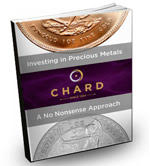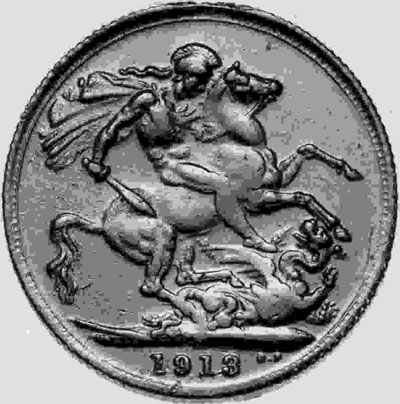This article "Sovereign Fakes", also appeared in the July 2004 issue of Numismatist.
In November 1954 a British Assistant Treasury Solicitor, Ralph Anderson, visited the Damascus moneychangers� market. He found openly quoted for sale, British made, Swiss made, Italian made and Syrian made gold sovereigns. Each had a different quoted price. The genuine British made sovereigns being the most expensive and the Syrian made fakes the least. Anderson was one of the leaders of the British fight against the post-war counterfeiting of the gold sovereign. This must have shown him how far he still had to go in his battle to prevent the counterfeiting of the sovereign.
In the twentieth century there was no significant counterfeiting of the sovereign until after the Second World War. By this time the sovereign had been completely replaced in every day use in the United Kingdom by bank notes. However in many areas of the world such as Greece and the Middle East the sovereign was still in great demand.
Large scale minting of the sovereign for circulation ceased in the London Mint in 1917. The six branch mints carried on making relatively small numbers of the coin for some time after this. The Pretoria Mint in South Africa made the last branch mint coins in 1932. This drying up of supply with an unsatisfied demand led to the price of a sovereign rising much more than the price of the gold it contained. London�s Evening Standard reported in 1952 that although the nominal value of the sovereign was one pound or twenty shillings, it contained �2-18 shillings of gold but sold on the continental markets from between �4 and �10.
This situation was to be exploited by a number of counterfeiters in the late 1940�s and the 1950�s. They used gold in their fake coins but were still able to make a handsome profit. In 1952 the alarm bells started to ring loudly in the British Treasury and the Royal Mint when the Swiss Federal Appeal Court refused to extradite two sovereign counterfeiters to Italy. One of these counterfeiters was a certain Jos� Beraha Zdravko, founder of one of the main counterfeit factories in Milan. The Swiss courts ruled that the sovereign could no longer be classed as money as it was not used as such in Britain.
A meeting of British government officials decided to authorise the Treasury Solicitor to take an active part in reversing this legal decision. Publicly the reasons for this were to protect the Royal Mint�s and the country�s prestige and commercial interests. In a confidential letter, S.Goldman from the Treasury appears to have stated the main motive in trying to prevent the counterfeiting of the sovereign:
Unfortunately we are not in a position to make public use of the argument that the copying of sovereigns may prevent us from employing them in our own semi-clandestine activities in the Middle East.
Ralph Anderson then took the lead in attempting to prevent this trade in counterfeit sovereigns. He brought professionalism and some would say a remarkable uncivil servant like energy to the task. He worked through British Embassies, their local legal advisors and with the prosecuting authorities. By July 1954 he was able to report that there were counterfeit sovereign cases before the courts in Milan (2), Turin, Coma, Trieste, Tangiers and Switzerland (3). By the end of that year the cases in Tangiers, Rome and Zurich had been successful. The Zurich case was crucial but taken by a canton level court and did not overturn the previous Swiss Federal Appeal Court ruling. There was one serious set back during the year when an Australian Court acquitted a defendant of counterfeiting sovereigns because they were not current coin. However the Australian government reacted quickly and the loophole in their law was changed by 1956.
There were initially two main centres used for making counterfeit sovereigns, Milan and Syria. The coins from Milan were mainly imported into Switzerland and then sent all around the world. Most were sent to Beirut for the Middle East market. Anderson after a visit in January 1956 said, Beirut is the Clapham Junction in the movement of gold in and out of the Near East. The Saudi Arabian Finance Ministry reputedly bought 50,000 of these coins directly from a group of Swiss based traffickers. These Italian counterfeits also went to South America, Western Europe and Greece. The Syrian counterfeits were used mainly in the Middle East or smuggled into India.
The Italian counterfeits were considered to be of a better quality than the Syrian coins. It was suspected by the British authorities that the so-called Swiss counterfeits were merely the best examples of the Italian coins that had been trafficked through Switzerland. During this time the Royal Mint assayed a large number of the counterfeits. The Italian coins, probably mainly from Beraha�s organisation, were found to usually contain between 91.2 to 91.7% gold whereas the Syrian/Lebanese coins, attributed to Chatile and others, varied between 88.0 to 91.5% gold. Genuine sovereigns always contain between 91.6 and 91.7% gold. Beraha was to later boast (Note 1) that he used more gold in his coins than the Royal Mint. The Royal Mint�s assays proved this boast to be as untrustworthy as his sovereigns.
It is difficult to quantify the scale of the problem with any certainty but it is probable that the number of counterfeits was vast. The Treasury estimated that there were up to 300 million sovereigns in circulation in the world in 1955. The Milan counterfeit factory operated by Beraha was one of the first to be closed by the Italian police. It was estimated to be able to produce up to a thousand coins a day. The Swiss police stated that between December 1952 and April 1954 one group of traffickers brought over 400,000 counterfeits into Switzerland from Milan. Again in 1955 Anderson noted an estimate that there was anything between one hundred thousand and a million Italian counterfeits in the 15 to 20 million sovereigns in Greece.
By 1956 the British felt their actions were having a significant impression on the manufacture of counterfeit sovereigns. However they were concerned that the legal position was still very precarious. A number of legal appeals were still underway and an adverse decision in any one of these would have reversed the advances made since 1952. After a review of the situation it was decided to add another line of attack to help solve the problem. This was to increase the supply of genuine sovereigns. In 1957 the Royal Mint made over two million, new currency sovereigns. It then made currency sovereigns annually, except for 1960 and 1961, up to and including 1968. This produced over 45 million new coins. These coins were not available inside Britain but kept in the Bank of England reserves and available to meet demand worldwide.
The increased availability of genuine sovereigns significantly reduced the price of the coin compared with the value of the gold it contained. The increase in supply was probably helped by a slow reduction in demand. C.M.Pirie of the British Legation in The Yemen observed, There seems to be at the present time a far greater trade in American dollars. This led Anderson to state in a letter in 1959, In my opinion, �counterfeiting in Europe has been substantially stopped but there are indications of renewed counterfeiting in Syria.
The reduction in the price of a sovereign over its gold price removed the profit to be made from counterfeiting sovereigns using a twenty-two carat (91.67%) gold alloy. The reports on the Syrian counterfeits claimed they contained significantly lower amounts of gold, 40 to 60% and compensated by being thicker than genuine coins. This, use of less gold than the genuine coin, generated the manufacturers profit. The moneychangers in the Middle East because of the counterfeits inferior quality easily identified these coins. In consequence they were bought and sold for a lower price.
From 1960 to 1970 the numbers of counterfeits made never again reach the levels of the early 1950�s. There was counterfeiting in Beirut in the 1970�s of collector gold coins and probably currency coins. The devastation of Beirut in the 1980s seems to have stopped production of these coins. The large-scale manufacture of these counterfeits does not appear to have resumed after this time, however there are still a number of the older fakes in circulation contaminating the sovereign stock. This is especially true in the Middle East.
A small sidelight on this whole issue was shown during the first Gulf War in 1991. British Special Forces were issued with packs containing a number of sovereigns to buy assistance from local people behind enemy lines. The Ministry of Defence bought these coins in the Middle East. It is perhaps not surprising that when these were examined after the end of the conflict a number were found to be counterfeit!
References
The main sources for this article are Royal Mint files deposited at the National Archive: MINT20-2317, 20-2318, 20-2319, 20-2320, 20-2321. These are titled, Counterfeit: sovereigns, and cover the period 1950 to 1959.
Note 1: Bloom, Murray Teigh, Money of their own: The Great Counterfeiters, London edition, Weidenfeld and Nicolson 1957.
Copyright Robert Matthews 2004





